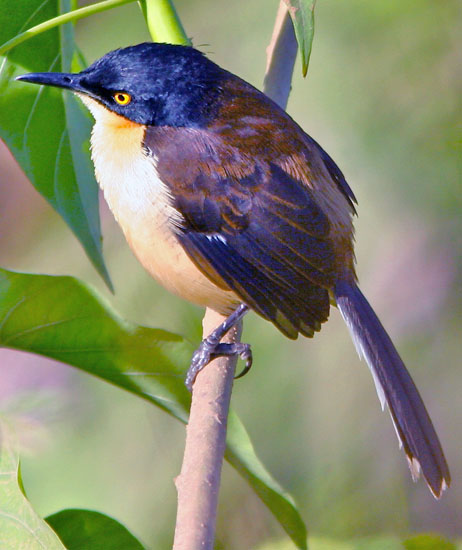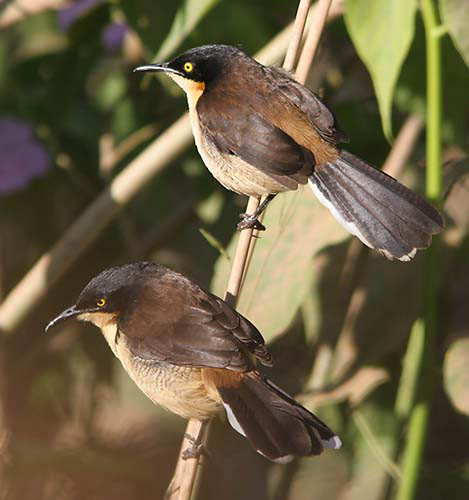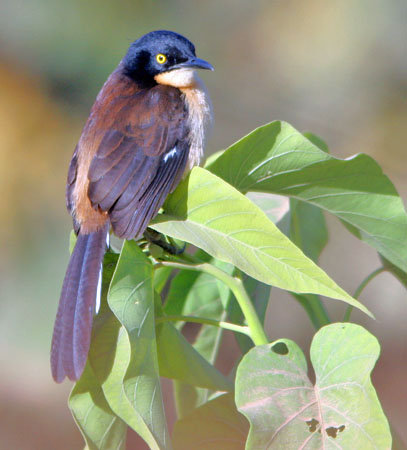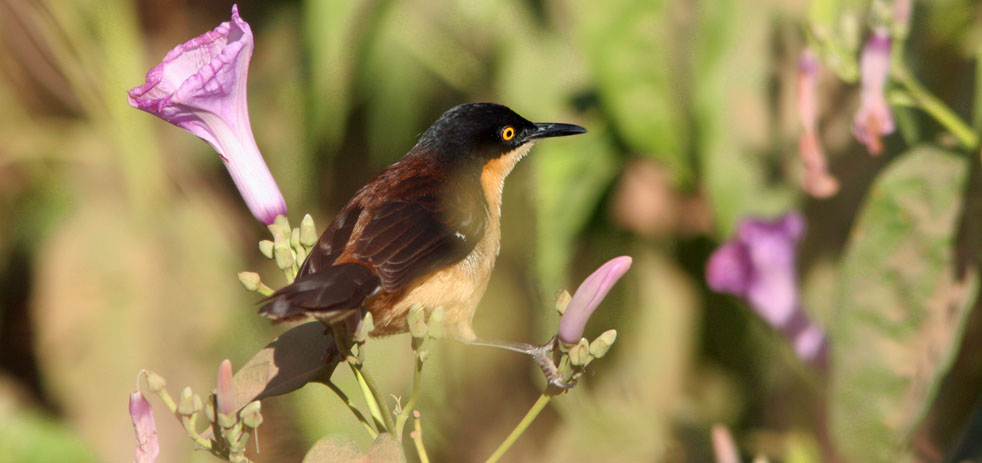| |
DONACOBIUS Donacobiidae |
- 1 species in the Neotropics
- DR personal total: 1 species (100%), 1 photo'd
|
 The Black-capped Donacobius (left) — often simply called Donacobius as there is no other species in the genus — is an aberrant monotypic species that is widely distributed primarily in the lowlands of tropical South America. It is a unique and easily recognized blackish-and-buff bird, with burnished sheen, of marshes or grassy areas near water. Pairs occupy narrow territories along the water's edge, vigorously displaying and dueting at territorial boundaries. For many years Donacobius was considered a mimid, and went by the name of "Black-capped Mockingthrush." This changed in 1982 when a paper given at the 100th A.O.U. convention (but not published) declared that "the Black-capped Donacobius is a wren, not a mimid." Behavioral studies in Peru, where 18 groups of banded birds were followed for three years, supporting this transfer (Kiltie & Fitzpatrick 1984). The species proved to be a cooperative breeder, with helpers at the nest in feeding young and territorial defense. This cooperative breeding behavior is more prevalent in wrens than in mimids; in addition, the vocal and display behaviors were unlike any mimid but rather like some Campylorhynchus wrens. Sibley & Ahlquist (1990) included Donacobius within wrens from DNA-DNA hybridization studies. The Black-capped Donacobius (left) — often simply called Donacobius as there is no other species in the genus — is an aberrant monotypic species that is widely distributed primarily in the lowlands of tropical South America. It is a unique and easily recognized blackish-and-buff bird, with burnished sheen, of marshes or grassy areas near water. Pairs occupy narrow territories along the water's edge, vigorously displaying and dueting at territorial boundaries. For many years Donacobius was considered a mimid, and went by the name of "Black-capped Mockingthrush." This changed in 1982 when a paper given at the 100th A.O.U. convention (but not published) declared that "the Black-capped Donacobius is a wren, not a mimid." Behavioral studies in Peru, where 18 groups of banded birds were followed for three years, supporting this transfer (Kiltie & Fitzpatrick 1984). The species proved to be a cooperative breeder, with helpers at the nest in feeding young and territorial defense. This cooperative breeding behavior is more prevalent in wrens than in mimids; in addition, the vocal and display behaviors were unlike any mimid but rather like some Campylorhynchus wrens. Sibley & Ahlquist (1990) included Donacobius within wrens from DNA-DNA hybridization studies.
Then a more recent study that sequenced nuclear and mitochondrial DNA (Barker 2004) showed that the assignment to wrens was conclusively excluded, as was assignment to any sister group or to mimids. Rather, the molecular evidence showed a potential relationship with Old World species, closest to white-eyes and prinias in the selected out-groups chosen. That is where the evidence stood in August 2004, when I created the first edition of this page.
So I created a Donacobiidae page: "It seems quite plausible that this unique taxa might be elevated to family status in the future. If it is related to some Old World lineage, it has been long separated from these relatives. It is possible that Donacobius is the lone remnant of some long ago Old World sylvoid radiation into the New World. It may be a relict, as appears to be the case with Sapayoa. . . . World birders would be wise to seek it out."
|
 |
 Fortunately, Black-capped Donacobius is not hard to find. Its full range extends from eastern Panama, across the Amazon Basin, and south as far as Bolivia and northeasternmost Argentina. It is widely distributed in Amazonia, and is particularly characteristic of oxbow lakes and floating vegetation in sluggish streams. Fortunately, Black-capped Donacobius is not hard to find. Its full range extends from eastern Panama, across the Amazon Basin, and south as far as Bolivia and northeasternmost Argentina. It is widely distributed in Amazonia, and is particularly characteristic of oxbow lakes and floating vegetation in sluggish streams.
Watching a dueting pair of Donacobius (above and right) can be fascinating. "They perch a few inches apart, one slightly above the other and usually facing the other way; they bob their heads, jerkily wag their partially fanned tails asynchronously, and call antiphonally, the upper bird giving a hard chrrr, and lower bird a loud kweéa. Often the orange skin on the sides of the neck is then exposed" (Ridgely & Tudor 1994).
While antiphonal dueting is present in some wrens, this description sounds a lot like the gonoleks of central Africa. They differ somewhat in behavior, though. Gonoleks tend to be secretive in the reeds while Donacobius often sits up in the open.
Black-capped Donacobius is entirely resident. A study of social organization and breeding (Kiltie & Fitzpatrick 1984) found that territories were maintained year round; that when one of a pair died or disappeared, the other pair remained in the territory; and that the missing spot was quickly taken by a member of a nearby group (although it could be as far away as the other end of the lake). Survival rate was high and although nestlings suffer high mortality, once fledged, youngsters have high survival rates until they disperse from the natal group. The nests are open cups in the reeds or grass; this is feature that is very unlike any wren (Kroodsma & Brewer 2005).
|
 I concluded my 2004 account this way: "So, despite initial placement as a mimids and then as a wren, Donacobius is a unique species. . . . I look forward to the Handbook of the Birds of the World discussion, in whatever chapter they place it." That proved to be Vol. 10 of HBW, published in 2005. Donacobius was placed with the wrens (Troglodytidae; Kroodsma & Brewer 2005), as the last species in that chapter, noting that it was not a wren "but an aberrant 'sylvioid', a group that includes babblers (Timaliidae) and the Old World warblers (Sylviidae)." I concluded my 2004 account this way: "So, despite initial placement as a mimids and then as a wren, Donacobius is a unique species. . . . I look forward to the Handbook of the Birds of the World discussion, in whatever chapter they place it." That proved to be Vol. 10 of HBW, published in 2005. Donacobius was placed with the wrens (Troglodytidae; Kroodsma & Brewer 2005), as the last species in that chapter, noting that it was not a wren "but an aberrant 'sylvioid', a group that includes babblers (Timaliidae) and the Old World warblers (Sylviidae)."
More recently Alström et al. (2006), also based on nuclear and mitochondrial DNA sequences, and with a thorough sampling of the entire superfamily Sylvioidea, confirmed with strong statistical support that Donacobius is indeed nested in the Sylvioidea, even though its phylogenetic affinities within this group could not be fully resolved. [It has been suggested that it could be closest to the Megalurus grassbirds now in family Locustellidae.] In any event, Aleixo & Pacheco (2007) proposed a new family for this monotypic genus: Donacobiidae. World checklist now tend to place it nest to the megalurid Grassbirds.
I've always from Donacobius to be fascinating birds, since I first encountered them at the oxbow lake like Cocachoca in Tambopata Nature Reserve, Madre de Dios Province, Peru, in June 1987. I've recently learned that they collect and habitually use shed snake-skins in their nests, at least in the Brazilian Pantanal (Almeida et al. 2014). So now I think of Donacobius following around Anacondas in the pantanal, to grab their shedding old skin. Is that cool or what? |
 |
| |
Photos: All the photos of Black-capped Donacobius Donacobius atricapilla on this page were taken in the Brazilian Pantanal on 19 July 2010, replacing the digitized slides used in my 2004 effort.
All photos © Don Roberson; all rights reserved.
Bibliographic note: There is no "family book" per se but Ridgely & Tudor (1989) has a good summary, as does Kroodsma & Brewer (2005), and details of their breeding biology and social organization are in Kiltie & Fitzpatrick (1984).
Literature cited:
Aleixo, A., and J.F. Pacheco. 2006. A family name for the monotypic oscine passerine genus Donacobius. Rev. Bras. Orn. 14 (2): 172–173.
Almeida, S.M., C. Strüssmann, and E.J. Anjos-Silva. 2014. Snake’s exuviae as habitual nesting material of the Black-capped Donacobius (Donacobius atricapilla) (Passeriformes: Donacobiidae) in the Pantanal wetlands. Ornitología Neotropical 25: 47–53.
Alström, P., P.G.P. Ericson, U. Olsson, and P. Sundberg. 2006. Phylogeny and classification of the avian superfamily Sylvioidea. Molec. Phylog. Evol. 38: 381–397.
Barker, F.K. 2004. Monophyly and relationship of wrens (Aves: Troglodytidae): a congruence analysis of heterogeneous mitochondrial and nuclear DNA sequence data. Molec. Phylog. Evol. 31: 486–504.
Dickinson, E.C., ed. 2003. The Howard & Moore Complete Checklist of the Birds of the World. 3d ed. Princeton Univ. Press, Princeton, N.J.
Kiltie, R.A., and J.W. Fitzpatrick. 1984. Reproduction and social organization of the Black-capped Donacobius (Donacobius atricapillus) in southeastern Peru. Auk 101: 804–811.
Ridgely, R. S., and G. Tudor. 1989. The Birds of South America. Vol. 1: The Oscine Passerines. Univ of Texas, Austin.
Kroodsma, D.E., and D. Brewer. 2005. Family Troglodytidae (Wrens), pp. 356–447 in Handbook of the Birds of the World (del Hoyo, J., A. Elliott & D.A. Christie, eds). Vol. 10. Lynx Edicions, Barcelona, Spain.
Sibley, C.G., and J.E. Ahlquist. 1990. Phylogeny and Classification of Birds: a Study of Molecular Evolution. Yale Univ. Press, New Haven, CT.
|
|
|



 The Black-capped Donacobius (left) — often simply called Donacobius as there is no other species in the genus — is an aberrant monotypic species that is widely distributed primarily in the lowlands of tropical South America. It is a unique and easily recognized blackish-and-buff bird, with burnished sheen, of marshes or grassy areas near water. Pairs occupy narrow territories along the water's edge, vigorously displaying and dueting at territorial boundaries. For many years Donacobius was considered a mimid, and went by the name of "Black-capped Mockingthrush." This changed in 1982 when a paper given at the 100th A.O.U. convention (but not published) declared that "the Black-capped Donacobius is a wren, not a mimid." Behavioral studies in Peru, where 18 groups of banded birds were followed for three years, supporting this transfer (Kiltie & Fitzpatrick 1984). The species proved to be a cooperative breeder, with helpers at the nest in feeding young and territorial defense. This cooperative breeding behavior is more prevalent in wrens than in mimids; in addition, the vocal and display behaviors were unlike any mimid but rather like some Campylorhynchus wrens. Sibley & Ahlquist (1990) included Donacobius within wrens from DNA-DNA hybridization studies.
The Black-capped Donacobius (left) — often simply called Donacobius as there is no other species in the genus — is an aberrant monotypic species that is widely distributed primarily in the lowlands of tropical South America. It is a unique and easily recognized blackish-and-buff bird, with burnished sheen, of marshes or grassy areas near water. Pairs occupy narrow territories along the water's edge, vigorously displaying and dueting at territorial boundaries. For many years Donacobius was considered a mimid, and went by the name of "Black-capped Mockingthrush." This changed in 1982 when a paper given at the 100th A.O.U. convention (but not published) declared that "the Black-capped Donacobius is a wren, not a mimid." Behavioral studies in Peru, where 18 groups of banded birds were followed for three years, supporting this transfer (Kiltie & Fitzpatrick 1984). The species proved to be a cooperative breeder, with helpers at the nest in feeding young and territorial defense. This cooperative breeding behavior is more prevalent in wrens than in mimids; in addition, the vocal and display behaviors were unlike any mimid but rather like some Campylorhynchus wrens. Sibley & Ahlquist (1990) included Donacobius within wrens from DNA-DNA hybridization studies.  Fortunately, Black-capped Donacobius is not hard to find. Its full range extends from eastern Panama, across the Amazon Basin, and south as far as Bolivia and northeasternmost Argentina. It is widely distributed in Amazonia, and is particularly characteristic of oxbow lakes and floating vegetation in sluggish streams.
Fortunately, Black-capped Donacobius is not hard to find. Its full range extends from eastern Panama, across the Amazon Basin, and south as far as Bolivia and northeasternmost Argentina. It is widely distributed in Amazonia, and is particularly characteristic of oxbow lakes and floating vegetation in sluggish streams. I concluded my 2004 account this way: "So, despite initial placement as a mimids and then as a wren, Donacobius is a unique species. . . . I look forward to the Handbook of the Birds of the World discussion, in whatever chapter they place it." That proved to be Vol. 10 of HBW, published in 2005. Donacobius was placed with the wrens (Troglodytidae; Kroodsma & Brewer 2005), as the last species in that chapter, noting that it was not a wren "but an aberrant 'sylvioid', a group that includes babblers (Timaliidae) and the Old World warblers (Sylviidae)."
I concluded my 2004 account this way: "So, despite initial placement as a mimids and then as a wren, Donacobius is a unique species. . . . I look forward to the Handbook of the Birds of the World discussion, in whatever chapter they place it." That proved to be Vol. 10 of HBW, published in 2005. Donacobius was placed with the wrens (Troglodytidae; Kroodsma & Brewer 2005), as the last species in that chapter, noting that it was not a wren "but an aberrant 'sylvioid', a group that includes babblers (Timaliidae) and the Old World warblers (Sylviidae)."